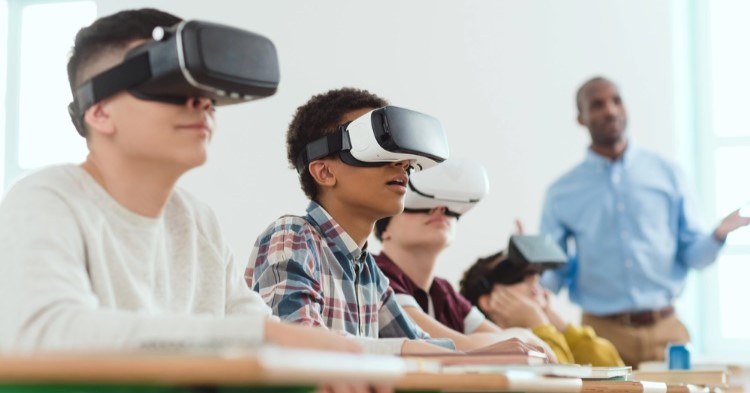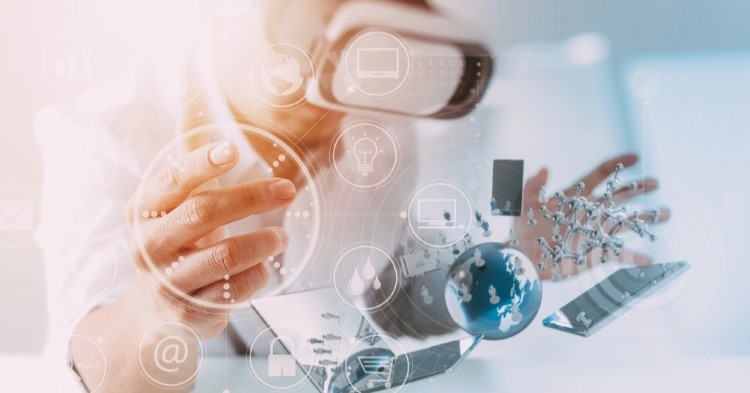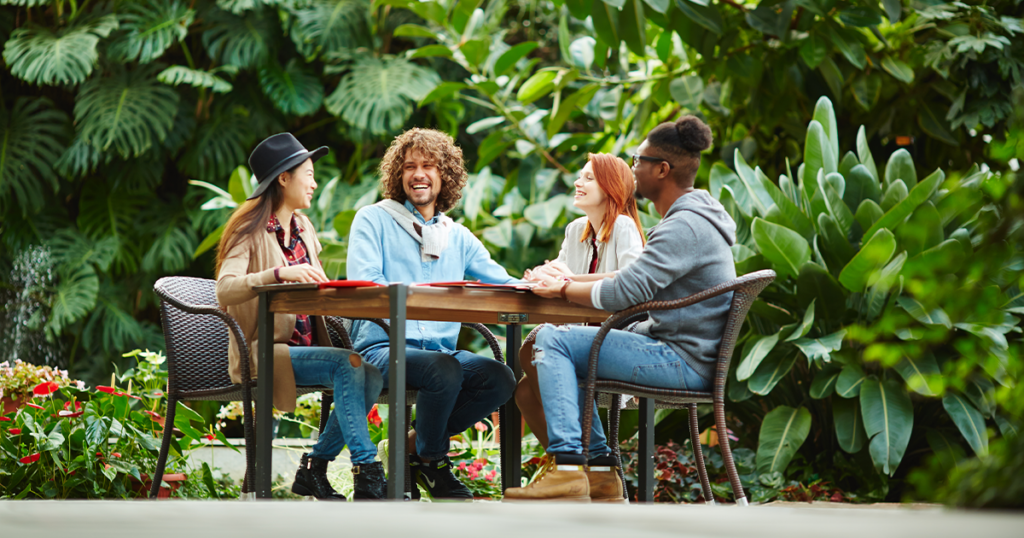How to Use Virtual Reality in Education and Training (+6 Real World Applications)
Since its invention, virtual reality has been a recurrent topic in many industries. While it first catered to the entertainment industry, nowadays many large organizations, like Volkswagen, use it in their employee training programs. Not only is it useful in the training field, but it has been a game-changer in the educational field as well, especially for those studying complex subjects in advanced or experimental sciences. It allows students to visualize concepts that might be difficult to understand through traditional methods like textbooks and lectures.
In this article, we will focus on the benefits and applications of virtual reality in education and training. There is a lot to cover, so let’s start by exploring how you can use VR to provide your students with new and improved ways of learning.

What Is VR (Virtual Reality) Technology?
VR technology is a simulated 3D environment that lets users explore and sometimes interact with a virtual setting. There are two general types of VR simulations: static images and dynamic environments. With a static simulation, an image is prerecorded in 360 degrees so that users can only look at it without interacting with it.
On the other hand, most VR programs are semi- or fully interactive and dynamic. These programs allow users to freely explore the virtual environment, interact with various objects, or engage in certain activities.
Not too long ago, this type of simulation technology used to belong only in science fiction books and our active imaginations. Today, users have the opportunity to engage in unique experiences that were previously unattainable.
What Are the Benefits of Using Virtual Reality in Education?
As an educational tool, VR has various applications in many fields, from sociology and history to engineering and biotechnology. More importantly, learners of all ages can make excellent use of VR in learning. In fact, even children in kindergarten can learn the alphabet and how to count numbers through entertaining VR games.
When you incorporate VR into a learning program, it can:
- Increase students’ engagement and retention: Interactive learning helps students retain information much better than passive listening. According to studies, an interactive VR program can keep students more engaged in a lesson than if they only listen to lectures.
- Encourage creative and critical thinking: Many interactive VR apps motivate students to use their critical thinking skills and solve problems. By extension, VR can encourage students to come up with and apply creative solutions to various problems; they can then try to recreate these solutions in real life (see research paper).
- Reduce equipment costs in certain industries: Traditionally, students in medicine, engineering, and other fields had to gain experience by using real machines and devices. Given how expensive that equipment can get, VR offers students a more cost-effective solution to gaining real-world experience.
- Allow students with learning difficulties to learn comfortably: For neurodivergent students or those with disabilities, VR can help them learn more comfortably by offering a new learning tool that can adhere to their learning style. Additionally, students who suffer from attention problems can also use VR to engage in lessons without getting distracted.
- Inspire students to explore new interests, subjects, and career paths: Using VR, students can try out different fields of interest without having to commit to a learning program. For example, a high school student can try learning music, chemistry, or even a new language without having to enroll in a complete course. This way, students get to make an informed choice about each subject and decide whether or not to pursue them.
Potential Usages of VR in Learning and Training
If you still believe that VR is just a promising educational tool in theory, then take a look at some of the following ways you can incorporate VR into your educational program to enhance your students’ learning experiences. Implementing VR in your classes can:
- Provide students with controlled environments to conduct experiments: In many fields of study, students have to deal with risky substances, locations, or other potential sources of danger. By exploring these environments in a controlled VR setting, students can acquire valuable hands-on experience without facing real-world dangers. In turn, students are allowed to confidently explore, make mistakes, and learn from failures without the fear of causing harm to themselves or others.
- Expose students to new cultures: Just as it can simulate labs and clinics, VR can also transport students virtually to different regions around the world. Whether they visit the Louvre or explore the Temple of Hatshepsut, students can experience different cultures first-hand at a fraction of the cost of actually traveling to those places.
- Introduce more immersive and interactive distance and/or remote learning: Many educational institutions offer remote and distance learning programs. However, these programs tend to cover theoretical knowledge and leave practical experiments to in-person classes only. Studies show that with VR, an institution can provide distance and remote learners with practical exercises, similar to the experiences of on-campus students.
- Aid children in developing motor skills and spatial awareness: Some students develop their motor skills much slower than others, while others have disabilities that can impair their academic progress. Fortunately, studies have shown that VR can help these students improve both their motor skills and their spatial awareness. It can aid them in overcoming some of the learning difficulties that their disabilities may cause them.

Examples of VR Implementation in Different Educational Programs
In order to create the best virtual reality learning environment for your students, you need to align the VR apps you’ll be using with their learning objectives. Additionally, some educational fields may require more interactive simulations, like science experiments for instance.
So, let’s explore how different educational fields use virtual reality for effective learning.
Medicine
One of the common use cases of VR in education is in medical schools. As a science, medicine consists of a vast collection of theoretical and practical studies that students can explore in VR.
Medical VR simulations tend to focus most on delicate operations like surgeries and transplants. In these simulations, students practice the procedures in the simulated environment, gaining familiarity with the operating room. Then, once they gain enough skill and precision in the simulation, they can start working with real patients.
STEM Fields
STEM fields cover several sciences, many of which have students working in potentially dangerous environments, such as chemical labs and construction sites. Moreover, some STEM subjects explore phenomena that we may not always have easy access to. For example, it can be difficult to show students an example of a supernova in real time, much less on demand!
When covering topics like these, VR can change the scope of STEM education using simulations of concepts that are impossible for humans to see otherwise. For instance, it’s possible to visualize what happens inside a particle accelerator through VR. As for hands-on work, students in engineering programs, for instance, can build models in VR to inspect them for any structural weaknesses.

Humanities
Subjects like sociology and history can be enriched through VR as well. If your students complain about reading textbooks all the time, why not take them on a trip across time? For example, you can use VR simulations to show them how the Pyramids of Giza were built, or have them attend a Victorian-era ball.
Immersive Language Learning
Many language teachers instruct their students to practice speaking in their target language. This can be difficult if there aren’t many people who speak that language in their area. And while traveling abroad is a great way to fix that problem, not everyone is able to nor can afford to do so.
The good news is that VR can also be used in language learning. Students can solve grammar exercises and practice their speaking skills through apps like Immerse VR, Mondly, and Language Lab VR. These apps can make practicing foreign languages more accessible and keep your students motivated to learn their target language.
Employee Training Programs
No matter the size of the company, VR can revolutionize employee training programs. Not only do companies manage to reduce the costs of employee training, but they also provide safe environments for employees to learn new skills. Particularly in high-risk departments, VR provides much safer ways to train employees up to professional standards without facing any danger.
Many companies have used VR simulations to train their employees in all kinds of skills, from improving presentation skills to reducing the number of electrical accidents in a factory. As a result, employees can continue their professional development at a productive pace.
Scientific Research
Lastly, many researchers know that some experiments are harder to conduct than others. Limited equipment capabilities or other constraints often hinder researchers from fully exploring certain variables. Consequently, gaps exist in our understanding across various fields. However, VR technology has changed the game. It allows researchers to explore under-researched concepts more easily.
For example, consider how difficult it is to study how sensory perception works for autistic individuals. Now, thanks to VR, researchers have access to the first-hand experience of autistic people’s sensory challenges. Armed with that knowledge, psychologists can better understand people on the autism spectrum and provide them with better care.

How to Find Educational VR Apps
Finding relevant VR apps and games for your students can be challenging, but you only need to know where to look. Here are three ways to find the best VR apps for your class.
1. Visit VR App Stores
The easiest way to find educational VR apps is by visiting the store libraries supported by your headset’s software. There are two main libraries to choose from:
- Meta Quest Library: The Meta Quest Library is a curated collection of VR apps and games that are fully supported on the Meta Quest headset. To access the library, simply open the Oculus app on your mobile device and select the “Library” tab.
- SideQuest: SideQuest is an independent app store that offers a wider selection of VR apps and games, including indie titles by independent creators. To access SideQuest, you will need to install the app onto your headset.
Once you find an app or game, you can decide whether or not it will be a good fit for your students by visiting review websites.
2. Contact VR App Companies
If you can’t find the right app for your students, you can always collaborate with a VR company to make customized software. Many VR app companies provide solutions that are tailored for educators and institutions.
Here are a few VR app companies that specialize in educational content:
- Varwin: Varwin is a company that develops VR simulations for training and education. You can use their VR apps in a variety of subjects and fields, like physics and mechanics.
- Bit Space Development: Bit Space Development is another company that specializes in VR apps for education.
What Are the Disadvantages of Using VR in Education?
While VR is a well-tested and reliable technology, there are still a few barriers to cross in order to bring that experience to your students. Depending on your region and institution, these barriers could be minor setbacks or complete dealbreakers.
Therefore, when adding VR to your educational assets, consider that:
- VR installation can get quite expensive: In many regions, VR equipment is costly to buy in large quantities. Additionally, you also have to invest time and money in training your staff to use it. However, VR setups are getting cheaper and more accessible as the demand for them continues to grow. Today, there are plenty of VR companies that offer special solutions for schools, like ClassVR.
- There are many prerequisite requirements to installing a VR system: Along with the monetary cost of the equipment, you must also create or purchase VR-compatible educational software. There’s also the problem of providing adequate space for students to use the equipment.
- The VR experience may not be accessible for students with severe or specific disabilities: While VR offers accessible learning for certain students, not all of them will be able to use it. For instance, blind students or those with severe motor disabilities will not benefit from VR at all. So, try to offer other options (like game-based learning) so none of your students face any major obstacles in their learning journey.

The Best VR Headsets for Education in 2025
If you’re ready to elevate your students’ learning experience, then you probably want to check out the available VR headsets on the market. There are quite a few options to think about, so take a look at the list below to find the right headset(s) for your students.
- ClassVR: If you need a VR headset that’s designed purely for educational purposes, look no further than ClassVR. You can request a quote for your institution here.
- PICO 4: As a contender in the VR market, the PICO 4 headset comes with stunning image quality and a competitive price tag. The 128GB storage model starts at $450 USD, but the price may vary by region and vendor.
- Meta Quest 3: The Quest 3 offers a high-quality VR experience at a fairly affordable price. You can buy this headset for $499.99 USD.
- HTC Vive Focus 3: While much more expensive than the first two options on this list, the Vive Focus 3 is the flagship headset you need for advanced simulations. Because of its top-of-the-line features, the Vive Focus 3 costs $1,300 USD.
- HTC Vive Flow: Finally, the Vive Flow is a great option if you need a headset that can connect seamlessly with your smartphone. However, this headset’s starting price is $499 USD, which may be considered a bit expensive for the features it offers.
Final Thoughts
Using virtual reality for learning might seem like a big leap from traditional and even online teaching. However, many educators have already made the decision to incorporate VR in their classrooms and reap its many benefits. So long as you can access the technology, you too can offer the unique VR experience to your students.
So, have you used VR in your own classroom? If so, tell us all about your experience in the comment section! We’d love to hear your thoughts.
.
Read More
Blended Teaching: Models, Benefits, Tools, and More!
Game-Based Learning: What It Is, and How to Apply It















